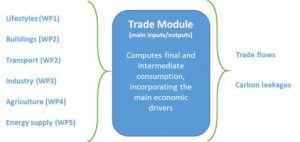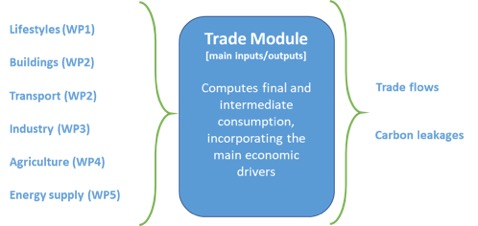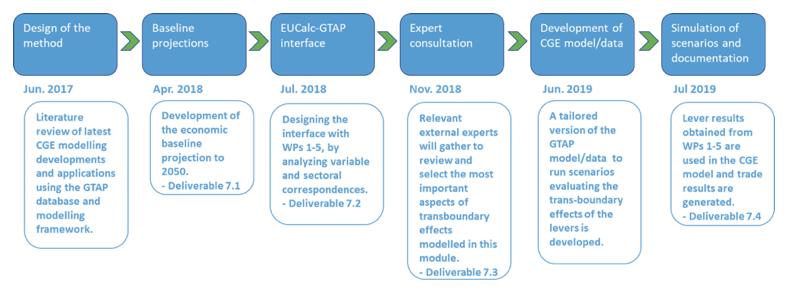Transboundary Effects, Trade & Flows
Work Package lead: University of Copenhagen
Module design
Calculation Flow & Input/ Output Matrix

The module design highlights interactions with other sectors or modules.
Implementation
Timeline, KNIME flow and progress documentation

A timeline and a flow visualization of the programmed module have been created to show progress and compare implementation to the module design
Your feedback and comments are much appreciated, questions will be addressed rapidly.
Module design
The scope of this module is to quantify the trans-boundary effects, including intra- and extra-EU trade flows, of EUCalc pathways at sectoral levels, as obtained from WPs 1-5, within a computable general equilibrium (CGE) modelling framework, in order to simulate perturbation to a projected baseline of the world economy.
In more detail, we employ ad hoc designed versions of the GTAP (Global Trade Analysis Project) model and databases, integrating this modelling framework with the core modules of the EUCalc tool. The GTAP’s extensive country coverage and its structure allow the exploration of sectoral and trade linkages within and across countries.
The research work of this WP includes the design of a baseline scenario representing the world economy in 2050 and modifications to the structure of the GTAP model (based on its existing variants) to accommodate the sectoral coverages of EUCalc. Finally, an EUCalc-GTAP interface is constructed and used to generate relevant results on transboundary effects by using the output of WPs 1-5 as inputs.
Inputs and Outputs Matrix

Data & Assumptions
The model is calibrated on the GTAP 9 Database (Aguiar et al., 2016). The database provides a full characterization of the world economy in the year 2011, covering 57 sectors (link) and 140 regions (link). This dataset is then projected to 2050 according to the baseline scenarios assembled in WP7, resembling a trajectory of social-economic development that is mostly likely to occur, given current and historical trends regarding the fundamental determinants of aggregated economic activities across countries.
The baseline scenario is defined and detailed in Deliverable 7.1. In the b aseline scenario, the assumptions on GDP growth are derived from the EU Reference Scenario 2016 (European Commission 2016) and from the OECD working group for the Shared Socio-economic Pathway 2 (SSP2) (Dellink et al., 2017). Assumptions on population are based on the recent joint work of the Economic Policy Committee and the European Commission (DG ECFIN) published in 2015 (European Commission 2015), and on IIASA projections for SSP2 (KC and Lutz, 2017).
References:
- European Commission 2015, The 2015 Ageing Report Economic and budgetary projections for the 28 EU Member States, European Economy 3.
- European Commission 2016, EU Reference Scenario 2016, Energy, Transport and GHG Emissions trends to 2050.
- KC, S. & Lutz, W. 2017. The human core of the shared socioeconomic pathways: Population scenarios by age, sex and level of education for all countries to 2100. Global Environmental Change, 42, 181-192.
- Dellink, R., Chateau, J., Lanzi, E. & Magné, B. 2017. Long-term economic growth projections in the Shared Socioeconomic Pathways. Global Environmental Change, 42, 200-214.
Implementation
Timeline
The work-package timeline is summarised in the figure below and highlights key milestones and expected outcomes.

Contact point
Contact for questions about the data and module
Wusheng Yu, wusheng@ifro.ku.dk
Francesco Clora, fc@ifro.ku.dk

